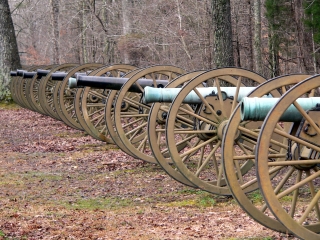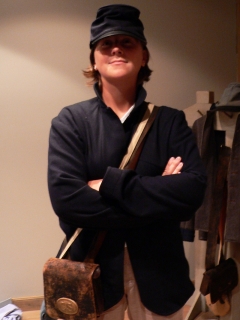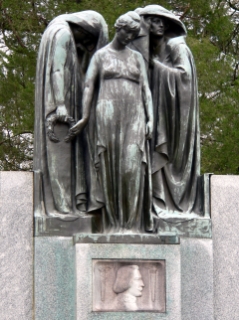NPS Website; Local Website
 WHAT IS IT?
WHAT IS IT?An exceptionally bloody April 1862 battle that finally convinced Americans that the Civil War was going to be long, difficult and increasingly horrifying.
BEAUTY (4/10)
The pleasant woodland, the wide Tennessee River and the Battlefield’s many open fields have changed little in the past 140 years. The setting is not much different from any rural landscape in this part of the country.
HISTORICAL INTEREST (7/10)
The Battle at Shiloh has taken on mythic importance in American history, partly because it was the first battle with major casualties, over 24,000, and somewhat because of its profoundly tragic name. Shiloh was a biblical place of refuge for the Israelites.
Tactically, Shiloh was the next fight after Fort Donelson in U.S. Grant’s aggressive push for control of the western theater of battle. Grant’s eventual success at Vicksburg would split the Confederacy in half.
CROWDS (6/10)
The driving tour of the Battlefield follows a circuitous route through monuments and tributes to those who fought. The path is long and isolated; crowds are evenly disbursed and should not affect your visit. We ran into the normal plethora of Civil War diehards dragging along their less than happy wives. We still not sure what connection the excited Scandinavian family of four had with Shiloh, perhaps the most out-of-place tourists we have seen.
EASE OF USE/ACCESS (1/5)
Shiloh NMP is located in southwestern Tennessee near Savannah, Tenn. NOT Savannah, Georgia. The Park is smack dab in the middle of nowhere. No Interstates run this way but many roads run into town.
Florence, Alabama is about 80 miles to the southeast; Jackson, Tenn. is about 60 miles to the northwest. Tupelo, Mississippi is 70 miles to the south; Columbia, Tenn. is 100 miles to the east. Those are the closest towns to Shiloh. Can anyone place any of those cities on a map? You really have to want to come here.
 CONCESSIONS/BOOKSTORE (5/5)
CONCESSIONS/BOOKSTORE (5/5)The Shiloh NMP bookstore is so big that it gets its own building. Included among its many categories of books are Regimental History, Local Native American History, African-American History and a slew of books just about Shiloh, including four different ones whose title is Shiloh.
You can look it up. The authors are Shelby Foote, Larry Daniel, Wiley Sword (that can’t be his real name) and James Lee McDonough. Not included is the Phyllis Reynolds Naylor children’s book, Shiloh, which is about a West Virginia dog and has nothing to do with the Battle.
COSTS (3/5)
Entry is $3 per person or $5 per family.
RANGER/GUIDE TO TOURIST RATIO (2/5)
There was one Ranger on duty at the Visitor Center.
TOURS/CLASSES (3/10)
The Shiloh NMP introductory film, Shiloh: Portrait of a Battle was done in 1956. It is abysmal. The footage is primarily re-enactors adorned with pasted on beards. It looks like U.S. Grant might even be portrayed by a woman but it is difficult to tell because of the grainy footage. According to a Ranger we met elsewhere, the film’s Battle saga is completely wrong. Historical research has disproven most of the film’s conclusions. The film is a mess and lacks the charm of other outdated Park films. Skip it.
The exhibits are dated as well, but at least they deliver some interesting trivia and short bios on the future celebrities that fought at Shiloh. Here are a few: John Wesley Powell (lost an arm at Shiloh but was the first man to raft the Colorado River); Lew Wallace (author of Ben Hur); James Garfield (Republican hero and future U.S. President); journalist Henry Stanley (the man who found Dr. Livingston in the Congo) and William LeBaron Jenney (the “father of the skyscraper).
Gab also enjoyed the period costumes that allowed you to dress up like a Civil War soldier. She picked the Billy Yank uniform. We then worried about knee jerk militancy from our fellow tourists, all Southerners.
 FUN (4/10)
FUN (4/10)We did not have much fun; battlefields are difficult places to tour. Shiloh is an anonymous piece of land that for a few days in April of 1862 became a killing field. It is impossible to separate Shiloh from its bloody past. All hikes lead down roads that played a prominent role in the fight. Many of them lead to mass Confederate graves. The Southern soldiers were never given the dignity of a proper burial.
WOULD WE RECOMMEND? (6/10)
Shiloh holds an important place in the hearts of many Americans. It was a place of great tragedy and loss. It is not tops on our list of tourist destinations but we may be in the minority; millions have read the many fictionalized accounts of the Battle.
If you do go, make sure you go to the new Corinth Interpretive Center 22 miles south of Shiloh first (our review tomorrow). The Corinth Center explains Shiloh well and makes up for the lack of educational opportunities at the Battlefield itself.
TOTAL 41/80
www.usa-c2c.com
© 2004-06